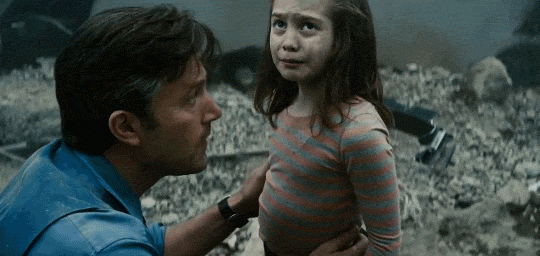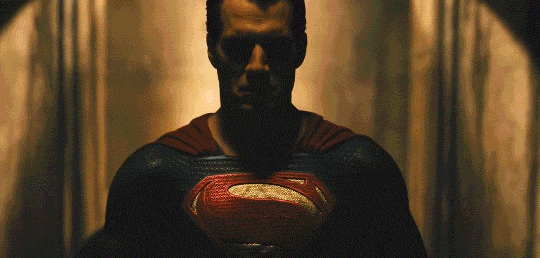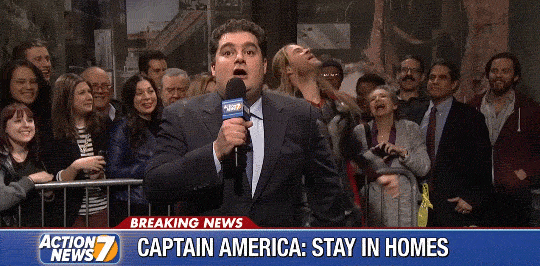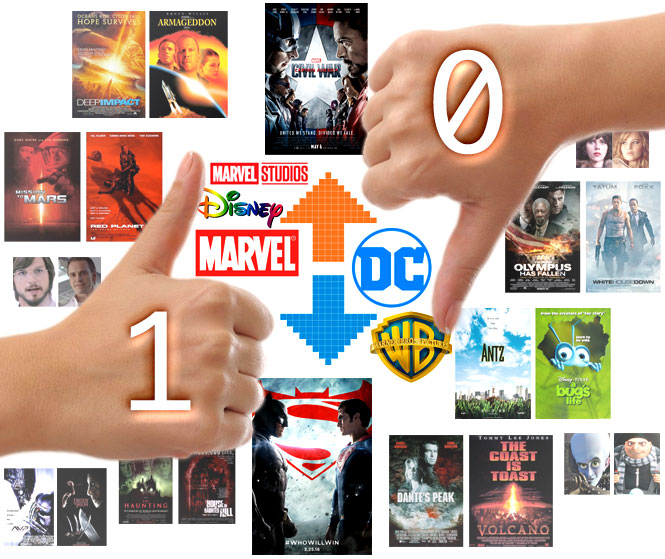How Haste Hurt the Heroes in Batman V. Superman: Dawn of Justice (2016)
The Real World of Distorted Perceptions
The opening dream sequence of the movie is followed by a flashback to the wide-scale destruction in Metropolis at the end of Man of Steel, as catalyst for Bruce Wayne’s renewed trauma. I’ve written previously about how I felt that the character of Superman was unfairly blamed for the destruction of Metropolis depicted in the battle with Zod and his Kryptonian renegades at the conclusion of Man of Steel (again, “The Misreporting of Manslaughter in Man of Steel (2013)”). So I really appreciated how the opening of Batman V Superman showed Bruce Wayne experience a direct–yet-selective perception of the urban destruction, ironically omitting as much of Superman’s heroism as the first DCEU movie’s detractors did. These moments are powerful and self-aware, and I felt they owned the criticism of the disaster-porn accusations leveled at Man of Steel, and leveraging them expertly to lay the foundations for Batman’s obsession. Once more, Lambie from Den of Geek praises the high point:
Bruce Wayne’s introduction into what was once Superman’s territory is also artfully done. The conclusion of Man Of Steel – itself controversial on the film’s release in 2013 – is seen again from street level, as Bruce races through the streets in a vain attempt to save his office building from inadvertently being destroyed during Superman and Zod’s apocalyptic punch-up. Yes, the way the Metropolis destruction recalls real-world events is as disturbing as it was in Man Of Steel, but here, we get more of a feeling of its senselessness – through Bruce, we’re shown the human consequences of that climactic battle.

The movie proceeds with a key sequence next upon which much of the Superman narrative relies: Superman’s rescue of Lois lane in the desert from a terrorist camp. It is a sequence that is significantly extended in the Ultimate Edition, but the end result of both cuts is: although Superman saves Lois, his taking that unsanctioned action overseas leads to a series of congressional hearings about overseeing his activity. We meet Lex Luthor, and it becomes clear he wants to arm himself against Superman with the newly-discovered Kryptonite. We meet a victim of the Battle of Metropolis, who hates Superman so much he is subject to hate-crime prosecution (!?) for defacing a statue erected in Superman’s honor.
As the movie proceeded, I began to feel the story owned too much of the criticism and accusations regarding its new, more darkly realistic incarnation of its time-honored character. It started in Man of Steel (and this movie) as a brave avenue to explore: leading nearly every character, and the audience itself, through a process of overcoming their fearful mistrust of him. Yet with themes distorting the real world and a dream-world, Batman V Superman heaps scenes of tremendous Zack Snyder visual power into compiling that mistrust—and establishes in the minds of the general audience an unintended dark portrait of the character overall. This is particularly true when the scene becomes indispensable… in that it is burdened with greater, universe-establishing purpose.
Another Dark Superman “dream sequence” is implanted later in the movie with far less subtlety: the heavily promoted “Knightmare” sequence, a key piece of the world-building for upcoming DCEU plotlines. All the other dream sequences arrive stealthily, but the extended dream about a future Earth taken over by a alien invasion force seemingly led by Superman elbows its way into the movie awkwardly. Missing the slow motion as well as the stealthy introduction, it executes heavy lifting in foreshadowing an upcoming conflict, for an upcoming movie. Yet like the psychic exposition scene in Man of Steel, the audience is left baffled: is it a dream we’re watching? Is it telepathy? Is is precognition? Whatever drives the imagery within the plot, in the movie the sequence stacks very powerful dark, frightening images of a seemingly evil Superman onto a movie reality already showing very little “bright side” to having Superman take any action at all, including the character’s single meaningful act in the movie (so far) of saving Lois.

This is intentional. Perhaps more clumsily (due to multiple purposes) than the rest of the film, the Knightmare scene furthers the expression of the distorted perceptions of Superman that are at the heart of the theme of the story. Batman V Superman is, like Man of Steel before it, both an adaptation and a deconstruction of its titular comic book heroes’ conventions. For Man of Steel, the movie challenged itself to follow in the footsteps of Christopher Nolan’s Batman trilogy in depicting its fantastical hero in a world as much like ours as possible. Batman V Superman starts with very much the same ambitions, and succeeds at first, but as its character’s motivations become less believable, and its plot less “real world” and accessible to the general audience, it’s success is mixed.
If you want a full detailing of the deconstruction methodology of the “Superman mythos” as Batman V Superman explored it, I’ve found a concise and coherent write-up as the single (so far) entry on a blog called Men Are Still Good: A Batman V Superman Blog, titled Deconstructing the Man of Steel- an analysis of how Zach Snyder, Chris Terrio, and the other contributors to the narrative of Batman V Superman grounded the superman. The nameless author details blow-by-blow the conventions cross-examined by the movie, acknowledging that the result may color fans’ reactions:
Alas, like any other deconstruction, there will be fans of the genre who feel betrayed and ask: what is the point of tearing down the conventions and traditions of a genre if those conventions are well loved? Well, I’ll respond by saying this: through deconstructing the many tropes of a character, one can analyze the tropes themselves and may also find the qualities, traits, and conventions associated with a character or genre that still holds up under heavy scrutiny and analysis. See, it’s easy for a creator to hide behind certain tropes because they’re crowd pleasers and nostalgic- but if you only rely on them you never have a chance to get to other and deeper aspects of the character by digging through the tropes that can become overused to the point of staleness. (alas, what happened to the superman character in the 90’s that led to his death).
Certainly there are some critics and audiences who disliked both Man of Steel and Batman V Superman: Dawn of Justice because of both movies’ subject matter and tone, just as there were viewers who didn’t enjoy The Dark Knight Trilogy’s interpretation of Batman (or specifically that of The Dark Knight Rises). Deconstruction pieces tend towards thoughtful defiance of expectations, as expressed here through contrasting these fantastical characters ideas in “the real world.” They are darker, more serious movies, and they stand in (to me, welcome) anathema to the Marvel Studios pictures’ less serious tones.

My wife asked me the other day how the news media and the average people in the Marvel Cinematic Universe responded to the revelation that, of all of Earth’s religions, it was Norse mythology that turned out to “be real.” I don’t know. Do you?
However if challenging the conventions of these heroes as they were re-introduced was all it took to drive review scores down, the disparity between the reception to Man of Steel versus its follow-up would be unexplained. But in bearing the weight of universe-launching and standing in for a follow-up to the individual Superman movie that preceded it, there’s simply not enough time with Superman as a hero in this movie, saving people. It was a valid complaint in Man of Steel, and in Batman V Superman it’s only gotten worse. Our eyes hungrily soak up the Day of the Dead rescue scenes, the music-only montages, as we also listen to a debate across the media about how Superman’s appearance challenges our notions of our place in the universe. The disillusionment is being broadcast along with the illusion, the deconstruction work eats itself because although construction of the hero myth—perhaps from other sources—may be complete, but the construction of the heroic character of Superman is not yet complete for the audience.

Batman V Superman thus attempts the ambition of a deconstruction piece and only partially succeeds, and it attempts the ambition of a universe-setup film (certainly Hollywood’s newest story type), and also only partially succeeds. Where it fails as a movie is connecting the narrative dots with character motivation lines, forming whole arcs for every character. This is where the challenges the film presents it myriad audience become unfair, the result of a rushed story, making room for its significant load of character-adding, universe-building junk in the trunk.
This is where the film forgets the obsession of the Nolan-verse predecessors in telling beginning-to-end character arcs for its most famous characters. It’s also where the film fails to measure up to its twin, released six weeks later, Captain America: Civil War.
Advertisement

